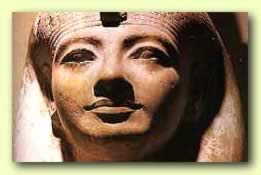return to Home Page
or move on to Goddess Myrrha, next chronologically,
or use Her Cyclopedia Index
Mut, Mother.
M1T
Alternate meaning: Vulture (in pre-dynastic times).
[to Whom the twenty-ninth day of September, day 272, is dedicated]

Geography/Culture: Egypt, especially Thebes where Her sanctuary was in use for 2000 years.
Description: Originally a vulture Goddess.
She became androgynous (Shehe was believed to possess both female and male reproductive organs); wing-armed Parent of the world; great and mighty divine Mother; Goddess of the sky; Caretaker of the dead; She from Whom the divine entities come forth; Protectress of motherhood; the Lady of Asheru; great sorceress; Mistress of Heaven; Eye of Ra.
To Whom Sacred: sycamore (in one work She is said to pour water from the sycamore tree over both the deceased and eris Ba, 'soul', (portrayed as a human-headed bird); papyrus scepter; vulture (vulture form head-dress is the ideogram of Her name); cow; lioness (She sometimes took the form of a cat-headed Goddess {presumably being then known as Ubasti, She-of-the-City-Bast}); horseshoe-shaped artificial lake; the united crowns of both Upper and Lower Egypt; ankh (symbol of life).
Festival: Annual celebration of Her marriage with Amon-Ra.
Male Associates: Consort: Ammon (Amen, Amen-Ra, Amon-ra, Amun-Re, Ammon-Re), solar deity. Son: Khons, moon god.
Titles/Variants, etc:
- She assimilated Ament, [She-Who-is-Hidden], below.
- Sometimes identified with Hat-Hor, Womb-of-the-Sun.
- The Greeks identified Her with their Hera, Our-Lady.
- She is sometimes identified with Isis, Lap-of-Power.
- Her horse-shaped lake recalls Leucippe, White-Mare.
- Mut, Mother, is sometimes confused with Nekhebet, Queen-of-Vultures, {perhaps because of Her earlier form as a vulture}.
- She is associated with Sekhmet, Powerful-One.
- Ubasti, She-of-the-City-Bast, with whom She is sometimes identified, may be a form of Her.
Ament, [She-Who-is-Hidden].
1M]NT
Alternate meaning: The-Westerner.
Geography/Culture: Egyptian.
Linguistic Note: amentet means the West, the land of the setting sun, where the dead assemble and wait to join the boat of the sun god Ra.
Description: She Who is the source of that mysterious and unknown power that causes conception in women and animals; Goddess of the dwelling place of the dead, and of their transformation.
Perhaps the true name of the Goddess Who offers the dead sustenance from a sycamore tree.
To Whom Sacred: cat; hawk; ostrich feather (ostrich plume and hawk was the hieroglyph for 'western', the province from which the Libyans came and whose normal ornament it was); uraeus, the coiled serpent; belly of a pregnant woman.
Iconography: Ament, She-Who-is-Hidden, is often portrayed with the crown of Lower Egypt.
Male Associates: consort, Amen, before he became Amen-Ra.
Titles/Variants, etc:
- Variant:
Amaunet.
- Variant:
Amenet.
- Variant:
Amonet.
- Variant:
Amunet.
- Title of Isis, Lap-of-Power, as She Who assists in transforming the bodies of the blessed dead into those who would live with Osiris.
- Hat-Hor, Womb-of-the-Sun, is also said to distribute sustenance to the dead from the branches of a tree.
Source: BEAW.BD/194; IV.EM/19, 100; MAS.WWEM/7-9, 99; NLEM.
worked on: September, August 1995; August, February 1991.
Return to the top of this document.
